Master Class with Cornelia Heard - Starling-DeLay 2025
It was one of those master classes where every violinist played so exceptionally - you kind of wonder what a teacher could possibly say. This is often the case at the Starling-DeLay Symposium on Violin Studies, where students are drawn from top programs around the country such as Juilliard Pre-College, The Colburn School and others.
Yet Cornelia ("Connie") Heard, a Professor of Violin at Vanderbilt University's Blair School of Music and member of the Blair String Quartet, worked with each of five student artists in a way that acknowledged their considerable accomplishments while also opening a door for further exploration. She offered some new angles on their playing, should they choose to explore them.
First on the program was Ria Kang, 9, who gave a beautiful performance of two advanced pieces in the violin literature: the final two movements from Bach's Sonata No. 3 in C major (the Largo and the Allegro assai) and Wieniawski's Etude Caprice No. 4.
Ria's "Largo" was elegant and sensitive, with excellent voicing; her "Allegro assai" was the whirl of notes that it should be, with noticeable gradations in the dynamics. The Wieniawski was incredibly fast - amazing she could be so nimble on a violin that is proportionally so large for her. (Again - see the bottom of this story - I'd like to make the case for our top luthiers to develop a line of Fine Fractional Violins for our still-growing virtuosos, so they can avoid the potential future injuries from playing on a too-big violin.)
Ria displayed so much virtuosity, the person next to me scrawled "I QUIT" in huge letters on her notebook! (It reminded me of the time I was trepidatiously trying to eke my way down a black ski slope, when a five-year-old went whizzing past me, slaloming around every bump with perfect confidence and ease...)
Okay everyone, don't quit, just be inspired!
Heard complemented Ria on her performance and then asked her what she thought of the Bach. Ria said that the Largo reminded her of the "dawn of morning," and perhaps Bach puzzling through some ideas.
Bach wrote this piece for violin alone, but it does have multiple voices. Heard asked Ria if she's ever played the beginning as a duet, and then proposed doing so - Ria played the melody while Heard played the bass line, sustaining the circled notes (below) for the full two beats or until the next bass note.

"Does that give you a different sense of it?" Heard asked. She said that in Ria's original playing of the piece, "some of the bass notes you sang beautifully, and some you barely touched." She wanted her to play all the chords, keeping the sustained bass in her head. "Focus a little more on the harmony," Heard said. "Music is so much about dialogue."
Also, in measure 8,

Heard pointed out that the cadence is a resolution, something that feels like when you come home and put on your pajamas. So it's important not to use a whole bow in m. 7, on the anticipatory notes before the cadence - in other words, don't make the anticipation louder than the resolution.
Heard also asked Ria if she had ever tried a Baroque bow, and when she hadn't, Heard fetched her own Baroque bow from her case and let her try it. (I later asked, Heard's Baroque bow was made by Harry Grabenstein of Williston, Vermont.)
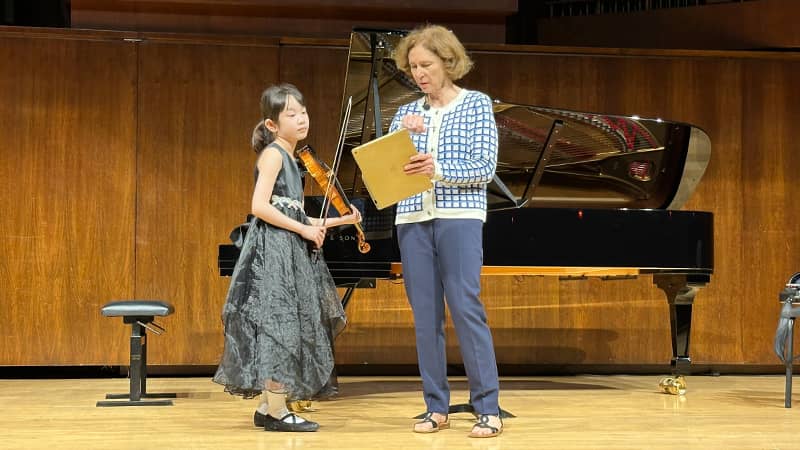
Cornelia Heard with student artist Ria Kang.
Heard said that using a Baroque bow can be incredibly helpful, "people use this and sometimes all their questions are answered."
Ria tried playing the "Allegro assai" with the Baroque bow, and Heard asked what she thought.
"It's very different," Ria said.
"It responds to a lighter stroke," Heard said, adding, "You sound like you've done it all your life!"
She said it can be fun to try Bach's original bowings, with the Baroque bow. She encouraged Ria to "try wildly different dynamics," in this movement, "whatever you are thinking, do more of it."
Next Jayden King, also 9, gave a fantastic performance of the third movement from Camille Saint-Saëns' Violin Concerto No. 3 - with pianist Evan Solomon doing a great job of both keeping pace and playing the orchestral interludes. I noticed Jayden's crisp, fast triplets and virtuosic delivery.
So did Heard, who praised his "extremely exciting and virtuosic," performance. She wanted to work on getting a little more expression, for example in this passage:
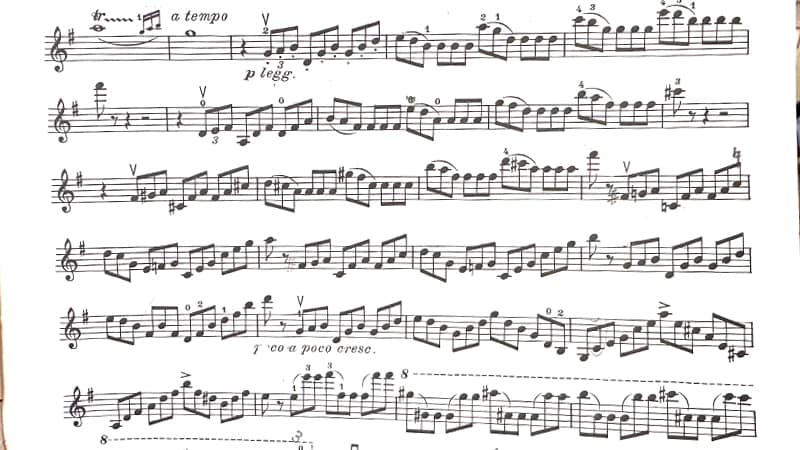
"Can you play it incredibly relaxed and jaunty, and can you tell me an entire story?" she said. He tried it again and he did quite well - a beautiful, long crescendo that was quite effective.
They moved on to a melodic passage, to work on making that more expressive.

"It may take exaggerating," she said, and it also might be necessary to put the breaks on the virtuosity - "you may have to say 'cool it' a little, for expressive reasons." She also wanted him to make sure his fourth-finger vibrato was as good as the other fingers.
She also had him try playing the melody, just in the lower half of the bow.
"I often have my students play with a quarter-size bow," which forces one to play in the lower half, Heard said. "If you get so you can play something in the lower half of the bow, then it's so easy - you have so many resources when you can use the whole bow."
She also pointed out that Jayden was playing with a locked bow thumb - she called it a "collapsed thumb" - which is to say it is collapsed backwards, as he appears to be somewhat double-jointed. She said that she, too has a very double-jointed thumb.
"It's hard to say that you have to fix it, because you are executing so well," she said. But making this change now will help bring more springiness and flexibility to the bow hand and fingers, she said.
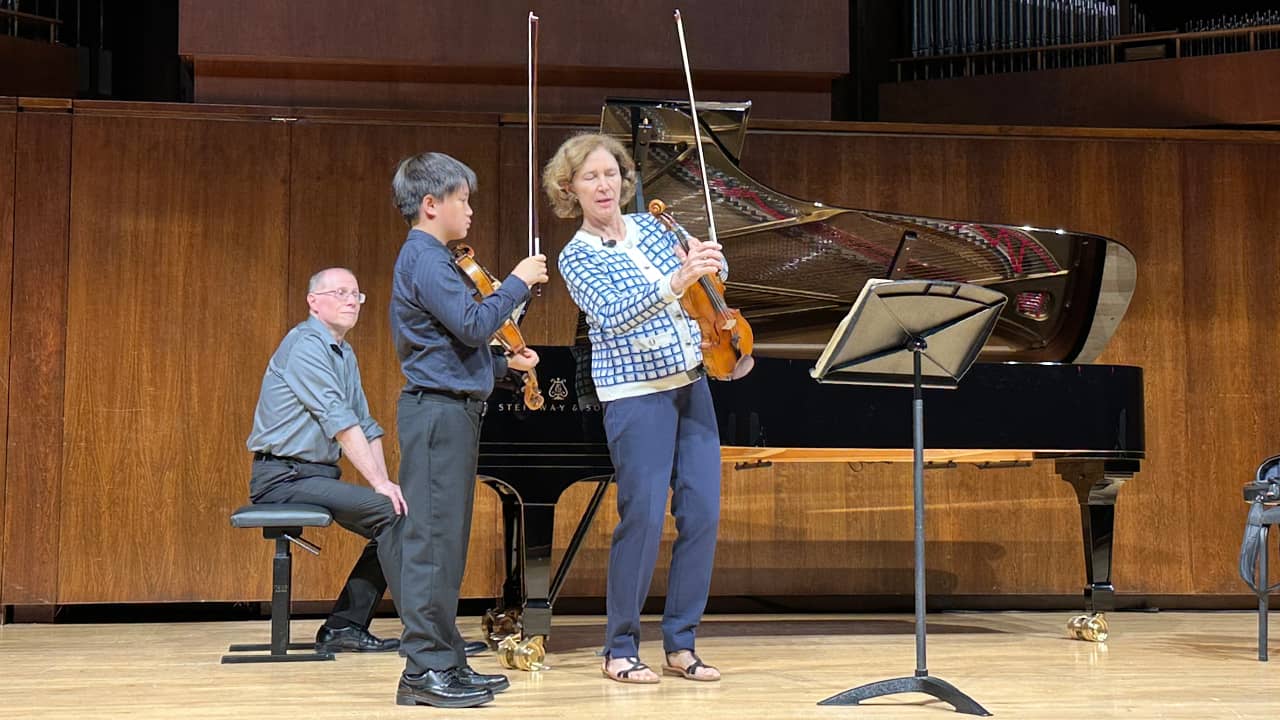
Cornelia Heard with student artist Jayden King.
She told him to strive for more of an "egg shape in the hand," which will give him more spring. She suggested practicing collé bow strokes (which come from the fingers) using Kreutzer Etude No. 7, "and don't let that thumb collapse."
She also encouraged him to be attentive to the pianist, in this case, Evan Solomon - "be in the same musical world with him, and be listening like crazy!"
Next was Maxwell Brown, a Juilliard Pre-College student who is also known for his prowess as a fiddler (I saw Max play fiddle for - and with - Darol Anger at a 2023 ASTA conference - quite extraordinary!)
Maxwell brought that easy spirit to the third movement from Mozart's Concerto No. 3 in G major, K. 216, playing in a very clear and elegant way, with a few of his own decorations for the short cadenzas in this rondo-form movement. His passagework was also extremely clean - and as we know, this is not easy in Mozart!
"You have a nice, relaxed approach," Heard said, also praising the fact that he wrote his own cadenzas. She went on to work with him on this passage:
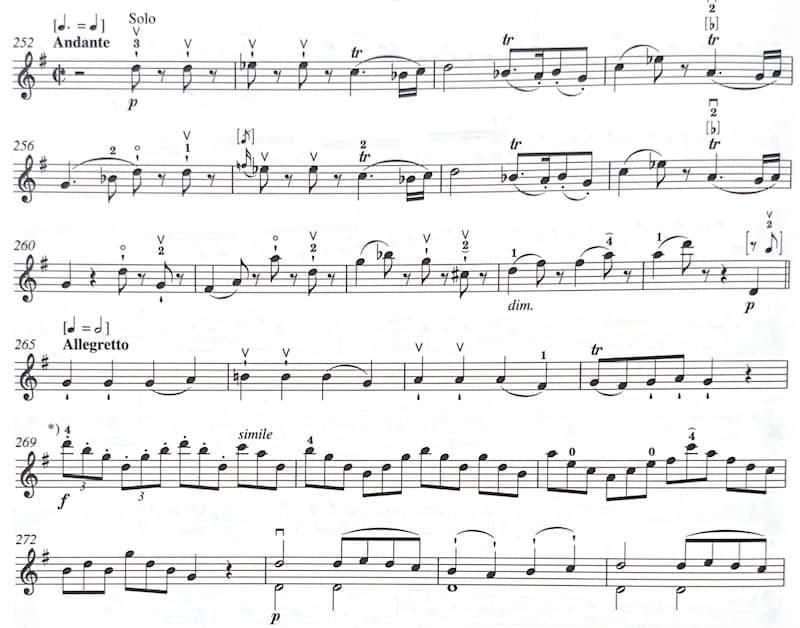
...and it seemed that both of them were just having a lot of fun with it!
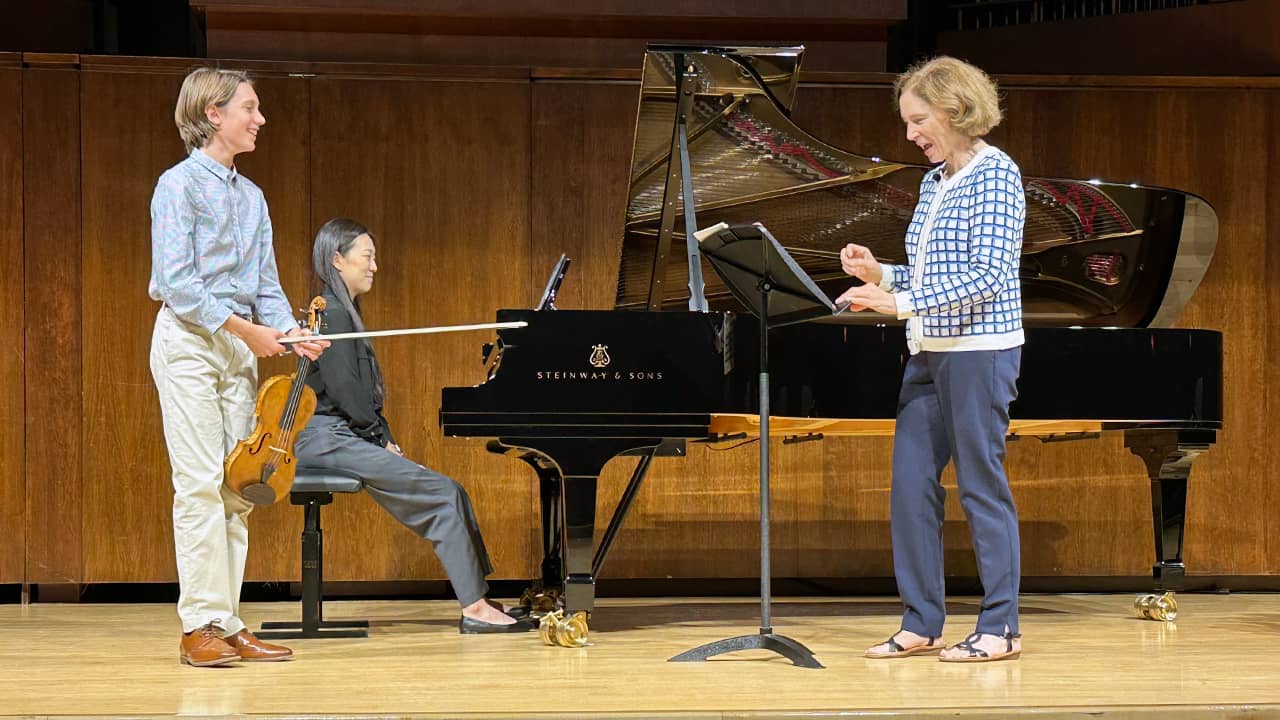
Cornelia Heard with student artist Maxwell Brown.
They practiced doing the up-bows at the beginning, and she also talked about the rules for trills, that if approaching from the same note or below it, they begin on the upper note.
At m. 260, the whole passage gets a little mysterious and spooky - "never rush this," she said. At m. 264, "could this end more like a question?"
Then the Allegretto that follows in m. 265 is a surprise - "you've got so much freedom in this, to romp and have a good time."
Next was a masterful reading (by memory) of the second movement Fuga from Bach's Sonata No. 2 in A minor, played by Dániel Hodos. While this music has become a regular staple of our violin literature, the basic fact of it still blows the mind: this is a three-voice fugue, played on one violin. "Sei Solo"? You are alone - with three voices! Hodos was so convincing with this, I wrote in my notes "what a privilege to sit in this room and witness all this talent."
After his performance, Heard complimented not only this performance, but also a performance that Hodos had given the night before in a student artist showcase, of both the Schubert/Ernst "Der Erlkönig" and a Paganini Caprice.
With all this excellence acknowledged - Heard still pushed for another level from him.
"There is a beautiful aesthetic in your playing that you could expand on, with a lot more variety," Heard said. "I'd like more responsiveness than that you have all of this beautifully laid out. I want to hear more conversation, more dialogue and dance."
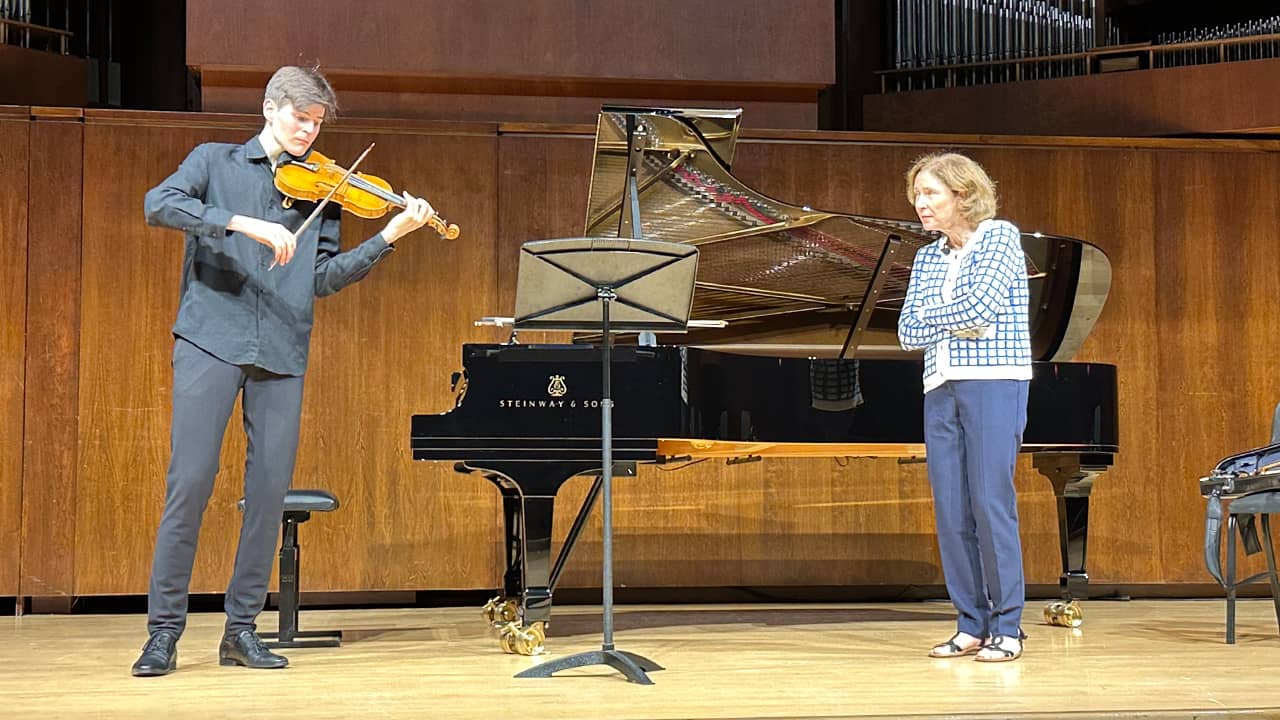
Cornelia Heard with student artist Dániel Hodos.
She wanted these three voices to talk with one another more - more personality, playfulness, contrast, conversation.
She had Hodos play the end of the Sonata's first movement, the "Grave," which ends on a double-stop octave E - the dominant in A minor - an unresolved chord. It only resolves in the next movement, and not until the second measure of the Fuga, when we finally get an A.

"The A is what is happening!" Heard said. She wanted it to sound "more playful, effortless."
She got out the Baroque bow again and let Dániel try it.
"How does that bow like your martelé?" she asked.
He was not so sure with it - "Not so much!" he said.
"Try to learn from it - do whatever feels right," she said.
He said that the grip felt very different - he was more at ease with the modern bow.
She also wanted him to spend less time for every phrase ending - "it has so many stops, I can't get going. " She wanted him to be careful about phrasing every two bars. With a five-page fugue, "we need to be unbelievably engaged throughout - each phrase should be incredibly alive."
To conclude the master class, Emrik Revermann performed the first movement of the Sibelius Violin Concerto.
Heard made an interesting point about the opening of the Sibelius, which is almost universally interpreted as a wind-chilled depiction of Sibelius's icy Finland. The composer actually wrote in a dynamic of mezzo forte, and "dolce ed espressivo."
"You can do whatever you want with that beginning," she said, but she did advise attending to the hairpins, particularly the decrescendos.
Heard told Emrik that "what you're getting is rich and singing, but let's test the edge."
She wanted him to test how the bow speed and pressure worked on all the "lanes" of the highway - that is, the five points of contact on the string where the bow can track, between the bridge and the fingerboard. The closest lane to the bridge is one, with five being at the fingerboard.
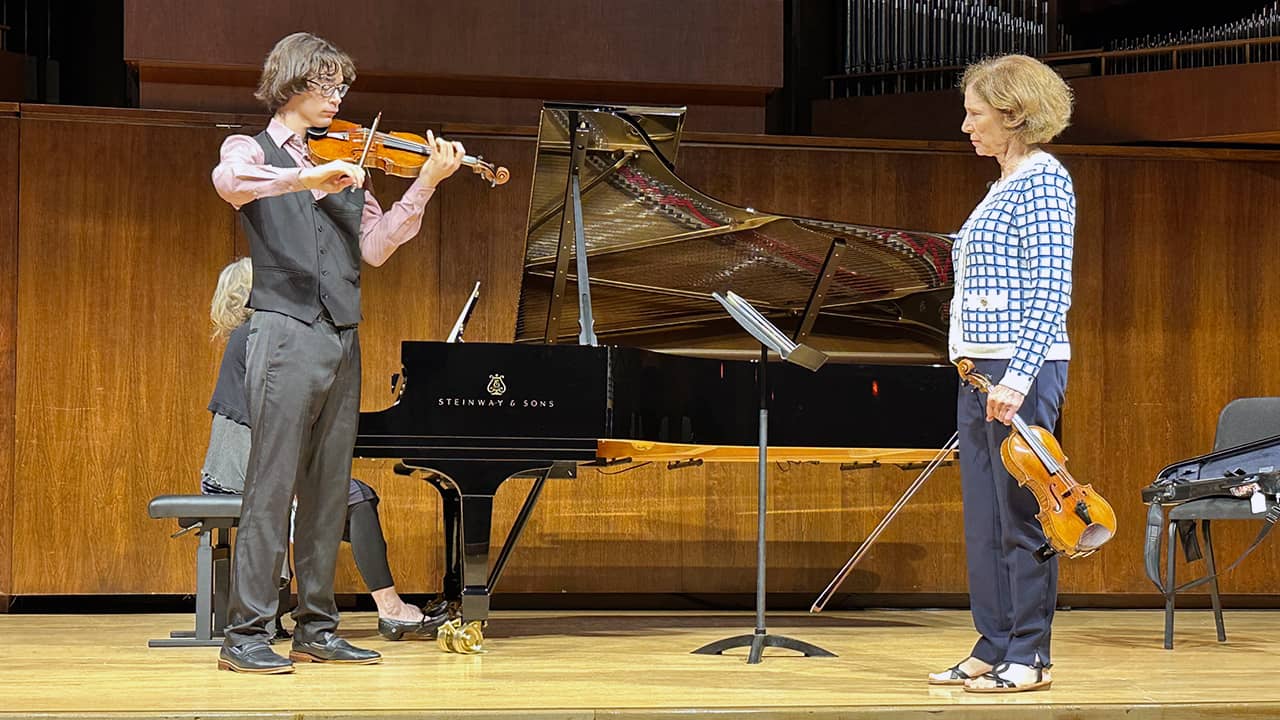
Cornelia Heard with student artist Emrik Revermann.
How much bow speed and weight is optimal for optimal sound, at each of these points? At "five," by the fingerboard, you need the most speed and the least pressure. At "one," right along the bridge, you need the slowest bow, with the most pressure. The points between - two, three, four - fall in between, along that speed-weight spectrum.
"You have to curate it, find what it takes," Heard said.
As is the case with many of us, he was having a hard time getting to lane one, right against the bridge.
"One is going to be pretty darn slow," Heard said. "You need more 'ones' and 'twos' in your playing. Experiment with playing closer the to the bridge." It will feel different and sound different, but the point she was making was that you can get more sound this way, without having to fight the instrument.
"You have a beautiful instrument and you can get more from it," she said. "But don't get tense." This is the way to get that big sound, without feeling like you have to press to make it happen. The other part of the equation is bow distribution: saving the bow and playing in the lower half.
"This is our most valuable real estate," she said. "It makes such a difference when you save the bow."
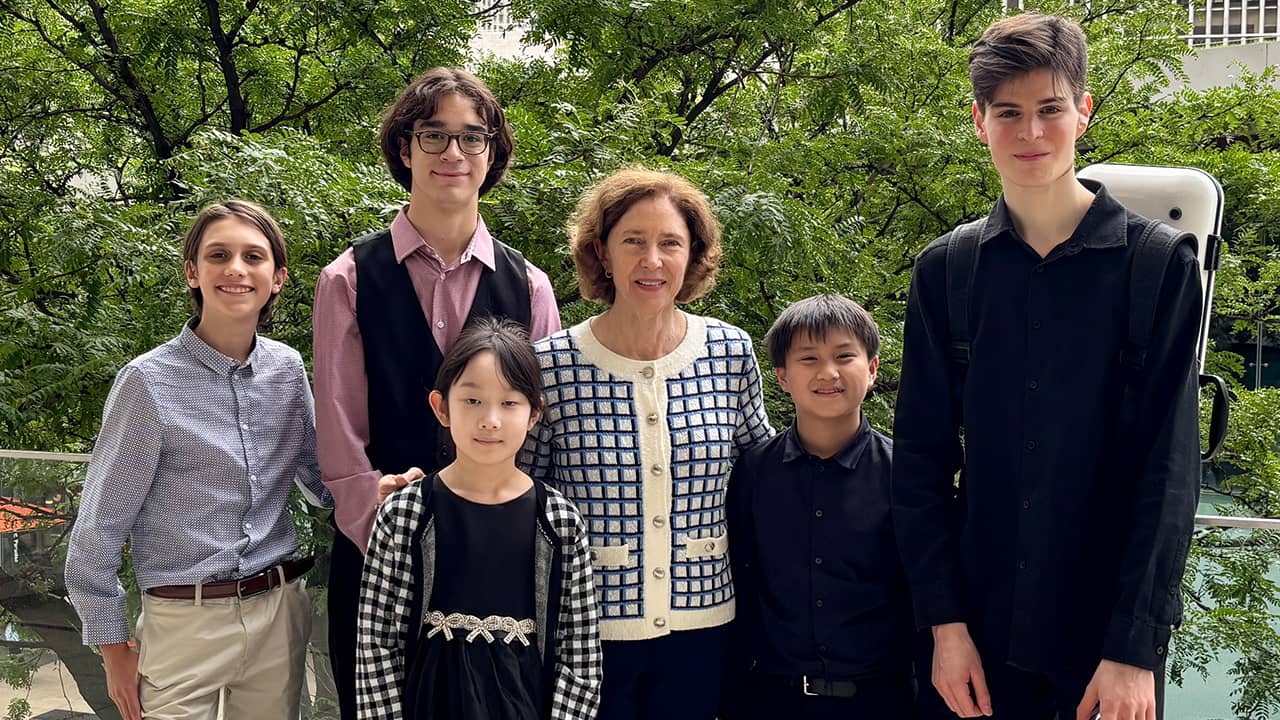
Cornelia Heard with master class students at the 2025 Starling-DeLay Symposium on Violin Studies.
You might also like:
- Master Class with Donald Weilerstein - Starling-DeLay 2025
- A Conversation with Violinist Itzhak Perlman
- Review: Violinists Jaime Laredo, Timothy Chooi and the Beauty of Live Performance
- All stories from Starling-DeLay Symposium on Violin Studies at Juilliard
* * *
Enjoying Violinist.com? Click here to sign up for our free, bi-weekly email newsletter. And if you've already signed up, please invite your friends! Thank you.
Replies
This article has been archived and is no longer accepting comments.
Violinist.com is made possible by...
Dimitri Musafia, Master Maker of Violin and Viola Cases
International Violin Competition of Indianapolis
Johnson String Instrument/Carriage House Violins
Subscribe
Laurie's Books
Discover the best of Violinist.com in these collections of editor Laurie Niles' exclusive interviews.

Violinist.com Interviews Volume 1, with introduction by Hilary Hahn

Violinist.com Interviews Volume 2, with introduction by Rachel Barton Pine







